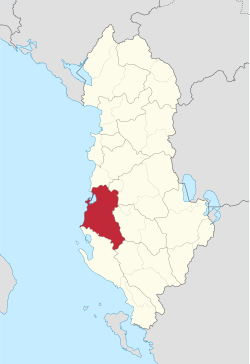Fier County
County of Fier
| |
|---|---|
 Seal | |
 Map of the Republic of Albania with Fier highlighted | |
| Coordinates: 41°15′N 19°45′E / 41.250°N 19.750°ECoordinates: 41°15′N 19°45′E / 41.250°N 19.750°E | |
| Country | Albania |
| Region | Southern Albania |
| Municipalities | show
6 |
| Units | show
42 |
| Capital | Fier |
| Government | |
| • Type | Council |
| • Chairman | Vangjel Ndreka (PS) |
| Area | |
| • Total | 1,890 km2 (730 sq mi) |
| Area rank | 8th |
| Population (2020) | |
| • Total | 289,889 |
| • Rank | 3rd |
| • Density | 150/km2 (400/sq mi) |
| Time zone | UTC+1 (CET) |
| • Summer (DST) | UTC+2 (CEST) |
| NUTS Code | AL032 |
| HDI (2018) | 0.765 high · 10th |
| Website | qarkufier.gov.al |
Fier County (Albanian pronunciation: [fieɽ]; Albanian: Qarku Fier), officially the County of Fier (Albanian: Qarku i Fierit), is a county in the Southern Region of the Republic of Albania. It is the eighth largest by area and the third most populous of the twelve counties, with more than 289,000 people within an area of 1,890 km2 (730 sq mi). The county borders on the Adriatic Sea to the west, the counties of Tirana to the north, Elbasan to the northeast, Berat to the east and Vlorë to the south. It is divided into six municipalities, Fier, Divjakë, Lushnjë, Mallakastër, Patos and Roskovec, with all of whom incorporate forty-two administrative units.
Geography[]
Until 2000, Fier County was subdivided into three districts: Fier, Lushnjë, and Mallakastër.[1] Before 2015, it consisted of the following 42 municipalities:
Demography[]
According to the last national census from 2011 this county has 310,331 inhabitants. Ethnic groups in the county include:[2]
- Albanians = 241,163 (77.71%)
- Greeks = 332 (0.11%)
- Macedonians = 18 (0.01%)
- Montenegrins = 5 (0.00%)
- Aromanians = 1,553 (0.50%)
- Romani = 1,640 (0,53%)
- Egyptians = 75 (0,02%)
- others = 171 (0.06%)
- no answer = 65,374 (21.07%)
Islam is by far the largest religion in the county, forming 48.52% of the total population (150,559 people). There are also some Bektashi Muslims with 1.01% (3,137 people), 7.15% percent consisting of believers without a denomination (22,186 people) and Christians forming 15.91% of the county's population (Orthodox (13.76%) (42,993 people), Evangelists (0.11% (331 people) (and Roman Catholics) (1.98%) (6,149 people).
See also[]
| Wikimedia Commons has media related to Fier County. |
References[]
- ^ "Law nr. 115/2014" (PDF). Archived from the original (PDF) on 2015-09-24. Retrieved 2015-06-03.
- ^ "2011 census results" (PDF). Archived from the original (PDF) on 2016-03-04. Retrieved 2015-05-25.
- Fier County
- Counties of Albania

